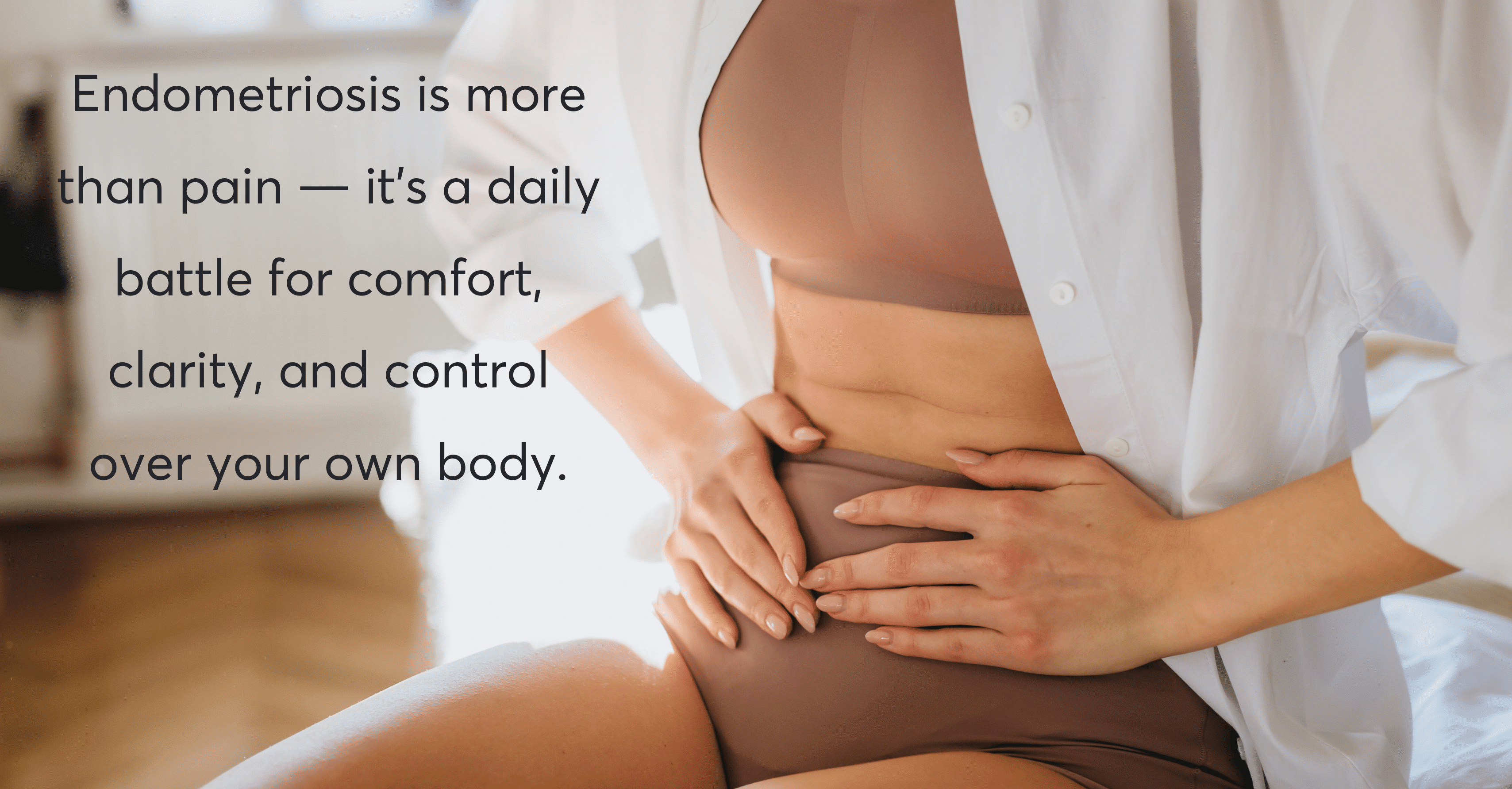
Endometriosis is a condition where tissue similar to the lining of the uterus grows outside of the uterus, leading to ongoing inflammation and the formation of scar tissue. This often results in intense pelvic pain. The exact cause of endometriosis is unknown, and there is no known way to prevent or cure it. Treatment typically involves medication or surgery to manage symptoms.
The Different Types of Endometriosis
- Superficial Endometriosis: Lesions (areas of abnormal tissue) are usually found in the pelvic area, on the lining of the abdomen.
- Cystic Ovarian Endometriosis: Lesions are mainly found in the ovaries.
- Deep Endometriosis: Lesions are found deeper in the body, in areas like the rectum, vaginal wall, bladder, or intestines.
In rare cases, endometriosis can also develop outside of the pelvic region.
Symptoms of Endometriosis
Endometriosis can begin with a person’s first menstrual period and continue until menopause, affecting people of all ethnic backgrounds and social statuses. For many, symptoms may improve after menopause. While some individuals may not experience any symptoms, others commonly experience pelvic pain, which can range from mild to severe. Pain is often felt in the following situations:
- During a period
- During or after sex
- When urinating
- When having a bowel movement
Other common symptoms of endometriosis include:
- Fatigue
- Nausea
- Bloating
- Heavy bleeding during or between periods
- Anxiety
- Depression
- Difficulty getting pregnant
Because the symptoms can vary widely, it is often hard to diagnose, and some people may not even realise they have the condition.
“Constant debilitating pain, brain fog, lack of energy, fatigue, feeling like a constant burden. Unable to give 100% in anything, not even 50%, always feeling sick. Unable to concentrate. Unable to perform sexually due to pain, unable to feel comfort in my body, feeling gross and undesirable. I feel like I have lost myself to endometriosis. I can’t plan ahead, I can’t have fun because it would lead to a flare up. I can’t eat what I want to. I can’t do anything that will cause me to have a flare up like washing the floor, dancing, cleaning the house, wearing tight clothing, wearing jeans or anything fitted and tailored with a button. Then there’s the mood swings and the depressive episodes, the anxiety and the constant dread of a flare up. There are no good days anymore – there are just not so bad or absolutely dreadful” – Shania Sciberras
What Causes Endometriosis?
Several factors may contribute to the development of endometriosis, including:
- Retrograde Menstruation: During menstruation, menstrual blood with endometrial cells may flow backwards through the fallopian tubes into the pelvic cavity. This can cause these cells to settle outside the uterus, where they begin to grow.
- Cellular Metaplasia: Cells located outside the uterus may change into cells similar to endometrial cells, leading to abnormal growth.
- Stem Cells: Stem cells can contribute to the development of endometriosis and allow it to spread to other parts of the body through the blood or lymphatic system.
Estrogen, a hormone that plays a key role in sexual and reproductive development in women, can also increase inflammation, growth, and pain associated with endometriosis.
“The pain, especially during menstruation, was unbearable. I am now 50. Reading the above comment I realise I too suffered from some of what Shania mentioned above, however, I did not know that they are related. In my case, when I was diagnosed, they just told me I have it and left me like that. No information and no help” – Melanie
How is Endometriosis Diagnosed?
Diagnosing this condition typically involves:
- A detailed history of menstrual symptoms
- A detailed history of chronic pelvic pain
- Imaging tests like MRI or ultrasound to detect ovarian cysts, adhesions, and deep forms of endometriosis
- Surgery or laparoscopy with tissue biopsy to confirm the diagnosis
It’s important to start medical treatment as soon as possible, even if a definitive diagnosis requires surgery or biopsy. Early treatment can help slow the progression of the condition and reduce long-term symptoms.
“It took ages to know I had endometriosis…ultrasound, MRI and finally a laparoscopy. Endometriosis is not just a heavy period. It’s an all-body illness. I can have a flare up because of inflammation caused by endometriosis at any time or day. Apart from pain, there’s fatigue and brain fog, which affect my everyday life. I follow an anti-inflammation diet to improve symptoms, but it still isn’t enough. Endometriosis has impacted my mental health, work and home, as sometimes I am too weak to function” – Anonymous
Treatment
While there is no cure for this condition, medications can help manage symptoms. Common treatment options include:
- NSAIDs (non-steroidal anti-inflammatory drugs) like ibuprofen to reduce pain
- Hormonal medications such as GnRH analogs and contraceptives (birth control pills, IUDs, vaginal rings, implants, injections, or patches) to manage symptoms (unless pregnancy is desired)
- Fertility treatments like medications or procedures (endometrial removal, intrauterine insemination (IUI), or in-vitro fertilisation (IVF)) to help with pregnancy if desired
- Surgery to remove endometrial lesions, adhesions, and scar tissue (note that recurrence of lesions after surgery is possible)
Treatment options should always be discussed with a healthcare professional. The best treatment plan should be chosen based on the individual’s needs, taking into account side effects, long-term safety, costs, and availability. Support groups can also offer helpful advice and emotional support.
The Way Forward…
Endometriosis affects many aspects of a woman’s sexual and reproductive health, as well as her overall well-being and quality of life. By supporting women’s right to comprehensive, holistic care, we can empower those affected by the condition.
Claire Galea is a mum of three currently reading for a Degree in Nursing at the Faculty of Health Sciences, University of Malta, as a mature student. She is keen about holistic patient-centered care as well as public education about health-related subjects, which she frequently writes about on Wham as a Content Writer and Website Editor.
Claire is also passionate about spreading awareness on the negative effects that domestic abuse leaves on its victims’ mental, emotional, social and physical wellbeing. She is the author of two downloadable ebooks, namely Heal Your Life Forever and 5 Simple Steps To Creating The Life Of Your Dreams.
Click here to check out Claire’s full bio as well as a list of all her Wham published articles





